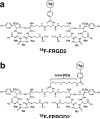18F-labeled mini-PEG spacered RGD dimer (18F-FPRGD2): synthesis and microPET imaging of alphavbeta3 integrin expression
- PMID: 17492285
- PMCID: PMC4167588
- DOI: 10.1007/s00259-007-0427-0
18F-labeled mini-PEG spacered RGD dimer (18F-FPRGD2): synthesis and microPET imaging of alphavbeta3 integrin expression
Abstract
Purpose: We have previously reported that (18)F-FB-E[c(RGDyK)](2) ((18)F-FRGD2) allows quantitative PET imaging of integrin alpha(v)beta(3) expression. However, the potential clinical translation was hampered by the relatively low radiochemical yield. The goal of this study was to improve the radiolabeling yield, without compromising the tumor targeting efficiency and in vivo kinetics, by incorporating a hydrophilic bifunctional mini-PEG spacer.
Methods: (18)F-FB-mini-PEG-E[c(RGDyK)](2) ((18)F-FPRGD2) was synthesized by coupling N-succinimidyl-4-(18)F-fluorobenzoate ((18)F-SFB) with NH(2)-mini-PEG-E[c(RGDyK)](2) (denoted as PRGD2). In vitro receptor binding affinity, metabolic stability, and integrin alpha(v)beta(3) specificity of the new tracer (18)F-FPRGD2 were assessed. The diagnostic value of (18)F-FPRGD2 was evaluated in subcutaneous U87MG glioblastoma xenografted mice and in c-neu transgenic mice by quantitative microPET imaging studies.
Results: The decay-corrected radiochemical yield based on (18)F-SFB was more than 60% with radiochemical purity of >99%. (18)F-FPRGD2 had high receptor binding affinity, metabolic stability, and integrin alpha(v)beta(3)-specific tumor uptake in the U87MG glioma xenograft model comparable to those of (18)F-FRGD2. The kidney uptake was appreciably lower for (18)F-FPRGD2 compared with (18)F-FRGD2 [2.0 +/- 0.2%ID/g for (18)F-FPRGD2 vs 3.0 +/- 0.2%ID/g for (18)F-FRGD2 at 1 h post injection (p.i.)]. The uptake in all the other organs except the urinary bladder was at background level. (18)F-FPRGD2 also exhibited excellent tumor uptake in c-neu oncomice (3.6 +/- 0.1%ID/g at 30 min p.i.).
Conclusion: Incorporation of a mini-PEG spacer significantly improved the overall radiolabeling yield of (18)F-FPRGD2. (18)F-FPRGD2 also had reduced renal uptake and similar tumor targeting efficacy as compared with (18)F-FRGD2. Further testing and clinical translation of (18)F-FPRGD2 are warranted.
Figures





Similar articles
-
Pegylated Arg-Gly-Asp peptide: 64Cu labeling and PET imaging of brain tumor alphavbeta3-integrin expression.J Nucl Med. 2004 Oct;45(10):1776-83. J Nucl Med. 2004. PMID: 15471848
-
Quantitative PET imaging of tumor integrin alphavbeta3 expression with 18F-FRGD2.J Nucl Med. 2006 Jan;47(1):113-21. J Nucl Med. 2006. PMID: 16391195 Free PMC article.
-
microPET of tumor integrin alphavbeta3 expression using 18F-labeled PEGylated tetrameric RGD peptide (18F-FPRGD4).J Nucl Med. 2007 Sep;48(9):1536-44. doi: 10.2967/jnumed.107.040816. Epub 2007 Aug 17. J Nucl Med. 2007. PMID: 17704249 Free PMC article.
-
[18F]FB-NH-mini-PEG-E{E[c(RGDyK)]2}2.2008 Feb 20 [updated 2008 Mar 12]. In: Molecular Imaging and Contrast Agent Database (MICAD) [Internet]. Bethesda (MD): National Center for Biotechnology Information (US); 2004–2013. 2008 Feb 20 [updated 2008 Mar 12]. In: Molecular Imaging and Contrast Agent Database (MICAD) [Internet]. Bethesda (MD): National Center for Biotechnology Information (US); 2004–2013. PMID: 20641437 Free Books & Documents. Review.
-
[18F]Fluorobenzoyl-PEGylated cyclic arginine-glycine-aspartic acid peptide.2008 Jun 11 [updated 2008 Jul 4]. In: Molecular Imaging and Contrast Agent Database (MICAD) [Internet]. Bethesda (MD): National Center for Biotechnology Information (US); 2004–2013. 2008 Jun 11 [updated 2008 Jul 4]. In: Molecular Imaging and Contrast Agent Database (MICAD) [Internet]. Bethesda (MD): National Center for Biotechnology Information (US); 2004–2013. PMID: 20641317 Free Books & Documents. Review.
Cited by
-
Recent developments on the application of molecular probes in multiple myeloma: Beyond [18F]FDG.Front Bioeng Biotechnol. 2022 Aug 26;10:920882. doi: 10.3389/fbioe.2022.920882. eCollection 2022. Front Bioeng Biotechnol. 2022. PMID: 36091426 Free PMC article. Review.
-
One-step radiosynthesis of ¹⁸F-AlF-NOTA-RGD₂ for tumor angiogenesis PET imaging.Eur J Nucl Med Mol Imaging. 2011 Sep;38(9):1732-41. doi: 10.1007/s00259-011-1847-4. Epub 2011 May 27. Eur J Nucl Med Mol Imaging. 2011. PMID: 21617974 Free PMC article.
-
The effect of mini-PEG-based spacer length on binding and pharmacokinetic properties of a 68Ga-labeled NOTA-conjugated antagonistic analog of bombesin.Molecules. 2014 Jul 17;19(7):10455-72. doi: 10.3390/molecules190710455. Molecules. 2014. PMID: 25036155 Free PMC article.
-
(64)Cu labeled sarcophagine exendin-4 for microPET imaging of glucagon like peptide-1 receptor expression.Theranostics. 2014 May 24;4(8):770-7. doi: 10.7150/thno.7759. eCollection 2014. Theranostics. 2014. PMID: 24955138 Free PMC article.
-
Strain-Promoted Catalyst-Free Click Chemistry for Rapid Construction of (64)Cu-Labeled PET Imaging Probes.ACS Med Chem Lett. 2012 Sep 19;3(12):1019-23. doi: 10.1021/ml300236m. eCollection 2012 Dec 13. ACS Med Chem Lett. 2012. PMID: 24900423 Free PMC article.
References
-
- Hynes RO. Integrins: bidirectional, allosteric signaling machines. Cell. 2002;110:673–87. - PubMed
-
- Cai W, Chen X. Anti-angiogenic cancer therapy based on integrin αvβ3 antagonism. Anti-Cancer Agents Med Chem. 2006;6:407–28. - PubMed
-
- Brooks PC, Clark RA, Cheresh DA. Requirement of vascular integrin αvβ3 for angiogenesis. Science. 1994;264:569–71. - PubMed
-
- Hood JD, Cheresh DA. Role of integrins in cell invasion and migration. Nat Rev Cancer. 2002;2:91–100. - PubMed
-
- Haubner R, Wester H-J, Weber WA, Mang C, Ziegler SI, Goodman SL, et al. Noninvasive imaging of αvβ3 integrin expression using 18F-labeled RGD-containing glycopeptide and positron emission tomography. Cancer Res. 2001;61:1781–5. - PubMed
Publication types
MeSH terms
Substances
Grants and funding
LinkOut - more resources
Full Text Sources
Other Literature Sources
Research Materials
Miscellaneous

